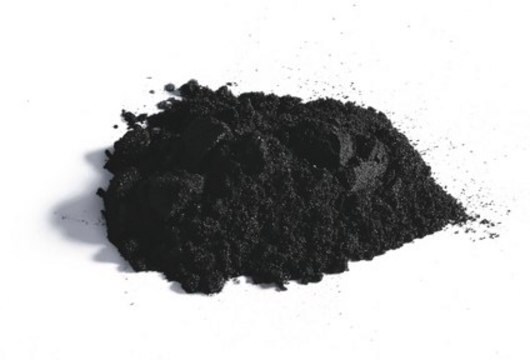05105
Aktivkohle
powder
Synonym(e):
Aktivkohle
About This Item
Empfohlene Produkte
Dampfdruck
<0.1 mmHg ( 20 °C)
Qualitätsniveau
Beschreibung
iodine-adsorption (0.05 mol I2/I) > 70 mL/g
methylene blue-adsorption > 12 mL/0.1 g 0.15% sol.
Form
powder
Selbstzündungstemp.
842 °F
Widerstandsfähigkeit
1375 μΩ-cm, 20°C (graphite)
Methode(n)
photometry: suitable
Glührückstand
≤2%
mp (Schmelzpunkt)
3550 °C (lit.)
Anionenspuren
chloride (Cl-): ≤5000 mg/kg
sulfate (SO42-): ≤5000 mg/kg
Kationenspuren
Ca: ≤1000 mg/kg
Cd: ≤10 mg/kg
Co: ≤10 mg/kg
Cr: ≤10 mg/kg
Cu: ≤10 mg/kg
Fe: ≤300 mg/kg
K: ≤200 mg/kg
Mg: ≤200 mg/kg
Mn: ≤50 mg/kg
Na: ≤500 mg/kg
Ni: ≤10 mg/kg
Pb: ≤10 mg/kg
Zn: ≤10 mg/kg
Anwendung(en)
food and beverages
general analytical
SMILES String
[C]
InChI
1S/C
InChIKey
OKTJSMMVPCPJKN-UHFFFAOYSA-N
Suchen Sie nach ähnlichen Produkten? Aufrufen Leitfaden zum Produktvergleich
Allgemeine Beschreibung
- Fiber coating to compare solid-phase microextraction efficiency of the multiwalled carbon nanotubes in water and milk samples before GC-ECD analysis.
- It may be used to study its effect on tissue cultures of Daucus carota, Happlopapus gracilis and Allum cepa var. proliferum, to check the adsorption of metabolites inhibiting morphognesis.
- It may also be used in the plant tissue culture to increase the adsorption of auxin and cytokinin from the culture media.
- It may also be used as the primary gastrointestinal decontamination procedure after acute drug overdose.
- It may also be used for the adsorption of dyes namely malachite green, bromophenol blue, alizarine red-S, methylene blue, eriochrome black-T, phenol red, methyl blue, and methyl violet from aqueous media.
- Oral activated charcoal may be also used for adsorption of theophylline, hence can be effectively used in patients with theophylline poisoning.
Lagerklassenschlüssel
11 - Combustible Solids
WGK
WGK 3
Flammpunkt (°F)
Not applicable
Flammpunkt (°C)
Not applicable
Persönliche Schutzausrüstung
Eyeshields, Gloves, type N95 (US)
Hier finden Sie alle aktuellen Versionen:
Besitzen Sie dieses Produkt bereits?
In der Dokumentenbibliothek finden Sie die Dokumentation zu den Produkten, die Sie kürzlich erworben haben.
Kunden haben sich ebenfalls angesehen
Unser Team von Wissenschaftlern verfügt über Erfahrung in allen Forschungsbereichen einschließlich Life Science, Materialwissenschaften, chemischer Synthese, Chromatographie, Analytik und vielen mehr..
Setzen Sie sich mit dem technischen Dienst in Verbindung.





